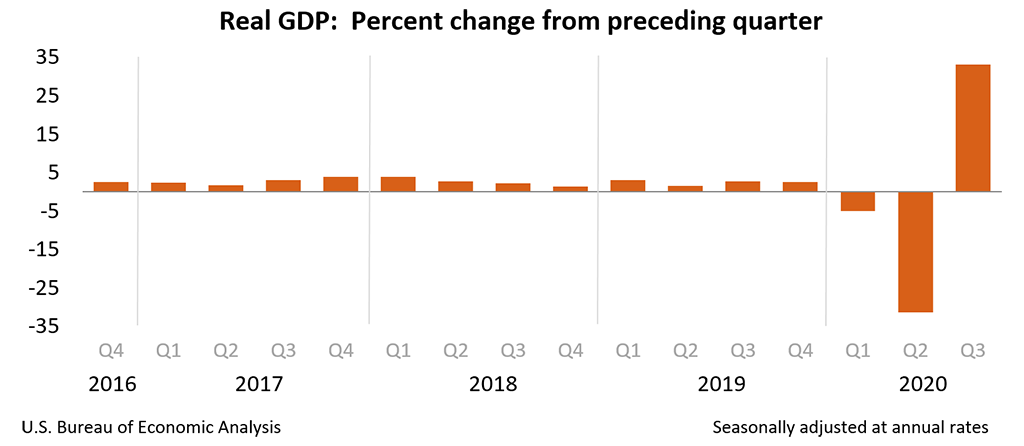Suitland, MD…Real gross domestic product (GDP) increased at an annual rate of 33.1 percent in the third quarter of 2020 (table 1), according to the “advance” estimate released by the Bureau of Economic Analysis. In the second quarter, real GDP decreased 31.4 percent. The increase in third quarter GDP reflected continued efforts to reopen businesses and resume activities that were postponed or restricted due to COVID-19. The full economic effects of the COVID-19 pandemic cannot be quantified in the GDP estimate for the third quarter of 2020 because the impacts are generally embedded in source data and cannot be separately identified. For more information, see the Technical Note.
The GDP estimate released today is based on source data that are incomplete or subject to further revision by the source agency (see “Source Data for the Advance Estimate” on page 2). The “second” estimate for the third quarter, based on more complete data, will be released on November 25, 2020.
The increase in real GDP reflected increases in personal consumption expenditures (PCE), private inventory investment, exports, nonresidential fixed investment, and residential fixed investment that were partly offset by decreases in federal government spending (reflecting fewer fees paid to administer the Paycheck Protection Program loans) and state and local government spending. Imports, which are a subtraction in the calculation of GDP, increased (table 2).
The increase in PCE reflected increases in services (led by health care as well as food services and accommodations) and goods (led by motor vehicles and parts as well as clothing and footwear). The increase in private inventory investment primarily reflected an increase in retail trade (led by motor vehicle dealers). The increase in exports primarily reflected an increase in goods (led by automotive vehicles, engines, and parts as well as capital goods). The increase in nonresidential fixed investment primarily reflected an increase in equipment (led by transportation equipment). The increase in residential fixed investment primarily reflected an increase in brokers’ commissions and other ownership transfer costs.
Current‑dollar GDP increased 38.0 percent, or $1.64 trillion, in the third quarter to a level of $21.16 trillion. In the second quarter, GDP decreased 32.8 percent, or $2.04 trillion (tables 1 and 3).
The price index for gross domestic purchases increased 3.4 percent in the third quarter, in contrast to a decrease of 1.4 percent in the second quarter (table 4). The PCE price index increased 3.7 percent, in contrast to a decrease of 1.6 percent. Excluding food and energy prices, the PCE price index increased 3.5 percent, in contrast to a decrease of 0.8 percent.
Personal Income
Current-dollar personal income decreased $540.6 billion in the third quarter, in contrast to an increase of $1.45 trillion in the second quarter. The decrease in personal income was more than accounted for by a decrease in personal current transfer receipts (notably, government social benefits related to pandemic relief programs) that was partly offset by increases in compensation and proprietors’ income (table 8). Additional information on several factors impacting personal income can be found in “Effects of Selected Federal Pandemic Response Programs on Personal Income.”
Disposable personal income decreased $636.7 billion, or 13.2 percent, in the third quarter, in contrast to an increase of $1.60 trillion, or 44.3 percent, in the second quarter. Real disposable personal income decreased 16.3 percent, in contrast to an increase of 46.6 percent.
Personal saving was $2.78 trillion in the third quarter, compared with $4.71 trillion in the second quarter. The personal saving rate—personal saving as a percentage of disposable personal income—was 15.8 percent in the third quarter, compared with 25.7 percent in the second quarter.
Source Data for the Advance Estimate
Information on the source data and key assumptions used in the advance estimate is provided in a Technical Note that is posted with the news release on BEA’s Web site. A detailed “Key Source Data and Assumptions” file is also posted for each release. For information on updates to GDP, see the “Additional Information” section that follows.
* * *



